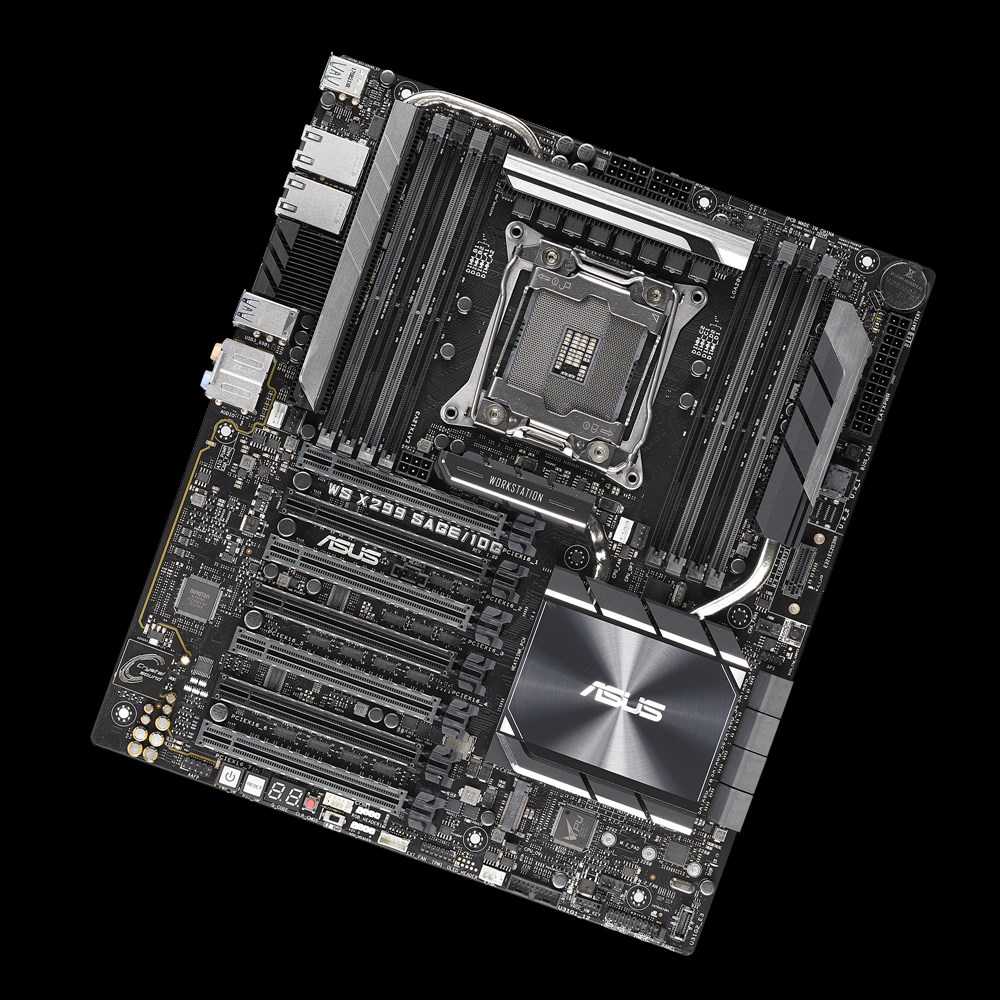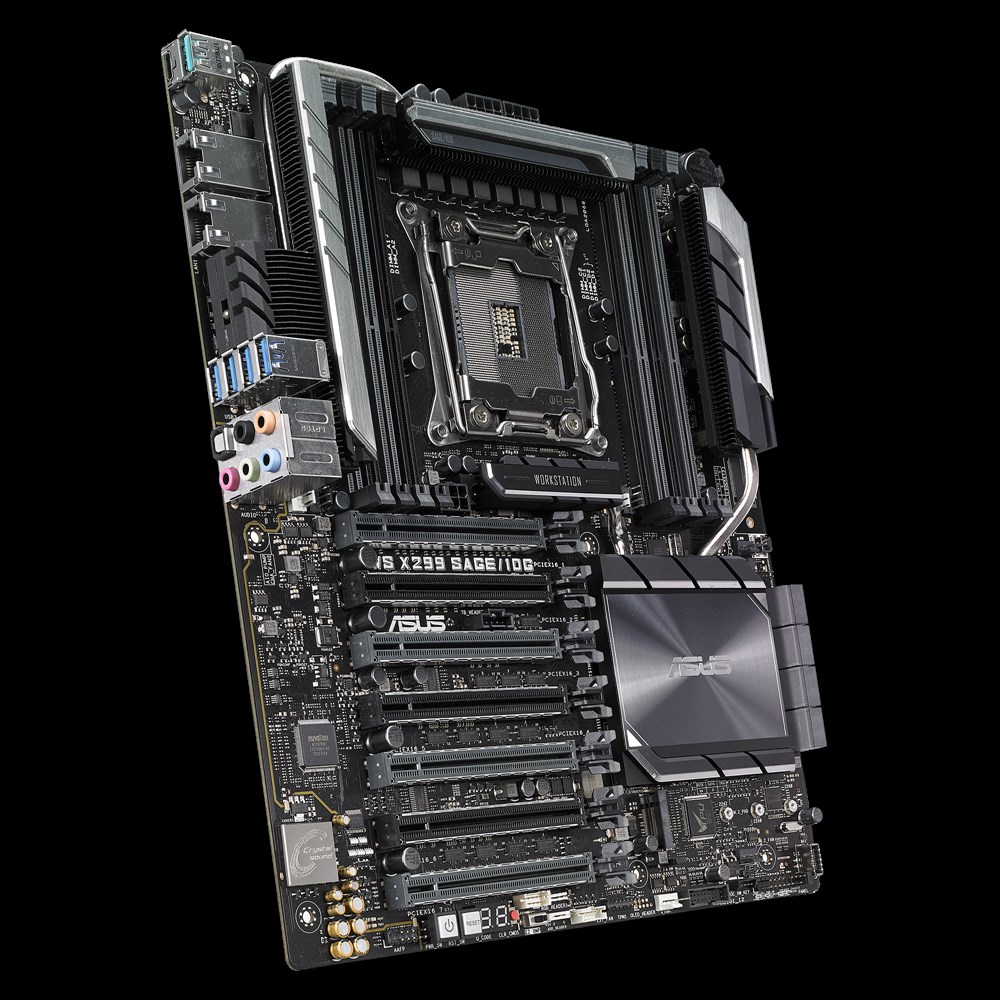Asus Future-Proofs The WS X299 Sage With Dual 10GbE Ports
Product revisions allow manufacturers to go back to the drawing board to amend what they didn't do right the first time or implement additional improvements to make a good product great. That's the case with Asus’ WS X299 Sage workstation motherboard, which debuted a few months ago alongside other X299-based premium enterprise motherboards like the WS X299 Pro and WS X299 Pro/SE. Although the WS X299 Sage is already the top dog of the trio, and maybe even of the workstation segment in general, Asus came up with a few new ways to kick the motherboard up an extra notch.
The WS X299 Sage’s makeover begins at the motherboard’s power-delivery subsystem. The WS X299 Sage/10G still has the same eight-phase digital design as its predecessor, but Asus beefed up the heatsinks quite a bit. The length of the primary heatsink has been extended to improve cooling performance while the secondary heatsink now extends to the back panel in the form of a stack of dense aluminum fins. The extended area probably cools the Intel X550-AT2 Ethernet controller, which brings us to the most significant upgrade on the WS X299 Sage/10G.
Asus has replaced both standard Gigabit Ethernet interfaces with two 10-Gigabit Ethernet ports. The Intel X550-AT2 chip, codenamed “Sageville,” is the Ethernet controller that powers and manages the new ports. However, Asus had to make a few sacrifices to accommodate the chip. As a result, the revised motherboard has lost four USB 2.0 ports, two USB 3.1 Gen 1 ports, and a U.2 connector compared to the original WS X299 Sage.
At the time of writing, Asus hasn’t revealed the pricing or availability of the WS X299 Sage/10G. The WS X299 Sage currently retails for around $503.66 on Amazon, and the Intel X550-AT2 chip costs approximately $79.61. That means the WS X299 Sage/10G will likely carry a price tag of around $600.
Get Tom's Hardware's best news and in-depth reviews, straight to your inbox.

Zhiye Liu is a news editor, memory reviewer, and SSD tester at Tom’s Hardware. Although he loves everything that’s hardware, he has a soft spot for CPUs, GPUs, and RAM.
-
collin3000 Definitely specialty workstation as I don't know many end or even power users that would trade 6 USB and a U.2 for 10gbe. Most buildings I've seen don't even have the wiring for it cause they're old and no one wants to pay for upgradesReply -
drtweak Reply21061572 said:Definitely specialty workstation as I don't know many end or even power users that would trade 6 USB and a U.2 for 10gbe. Most buildings I've seen don't even have the wiring for it cause they're old and no one wants to pay for upgrades
I can't say anything about the U.2 (Except for how I hardly know anyone who uses it to begin with) but that is what USB hubs are for. Unless you NEED that bandwidth, which honestly most people do not, I don't see any issue with losing those items for the dual 10GB port.
Now only if they could make this in a Mini ITX, and with just 1 10GB port will be fine for my server. -
Giroro I guess 10 Gbps Ethernet in a workstation is the kind of thing you already know if you need.Reply
Out here in the "silicon slopes" though, 150 Mbps "business class" internet is so new and exciting that Comcast thinks they need to run TV ads about it.
Or that's what they were doing before June 11th at least. I can't imagine Comcast needs to pretend they need to advertise anymore since they apparently own most the infrastructure in the state. -
JonDol Reply21065161 said:Unless you NEED that bandwidth, which honestly most people do not
Hey there,
We are not talking here about "most people". "Most people" do not need a 600 USD MB. We are not talking neither about the NEED: it is already here and these, now enthusiast class, MB are just 10 years late. Most of the people interested in such motherboards were saturating the 1 Gbps 10 years ago, long before 1 Gbps internet at home become common.
Cheers
-
velocityg4 Very niche product. I'd think removing the remaining U.2 port and adding built in Thunderbolt 3 to the USB-C would be much more tempting for enthusiasts and pros.Reply -
b2candy Is this the point where I say that ASUS used the exact same controller on the X99-E-WS/10G board several years ago? It's not a new controller.Reply
I'm surprised they didn't have a 10G variation in the first place. So this isn't an update, it's just a new board with the same base design but with a different controller on it. The controller we've already had for a generation. -
velocityg4 Reply21070033 said:Is this the point where I say that ASUS used the exact same controller on the X99-E-WS/10G board several years ago? It's not a new controller.
I'm surprised they didn't have a 10G variation in the first place. So this isn't an update, it's just a new board with the same base design but with a different controller on it. The controller we've already had for a generation.
Best I can tell the X550 is Intel's most recent 10Gbase-T controller. X710 has some more recent cards but the chipset was introduced earlier. Also it looks as though it can hit 5gbE on CAT 5. Not sure how they pulled that one off. Sounds great for someone who wants more speed without replacing their cables. -
drtweak Reply21069766 said:21065161 said:Unless you NEED that bandwidth, which honestly most people do not
Hey there,
We are not talking here about "most people". "Most people" do not need a 600 USD MB. We are not talking neither about the NEED: it is already here and these, now enthusiast class, MB are just 10 years late. Most of the people interested in such motherboards were saturating the 1 Gbps 10 years ago, long before 1 Gbps internet at home become common.
Cheers
The NEED was NOT the dual 10Gb ports but loss of the other times like the USB 3.0 ports lol. The NEED for this board is having that dual 10GB ports.

